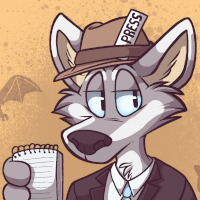Franko: Fables of the Last Earth, by Cristóbal Jofré and Ángel Bernier – review by Fred Patten.
by Patch O'Furr
Submitted by Fred Patten, Furry’s favorite historian and reviewer.
 Franko: Fables of the Last Earth, by Cristóbal Jofré and Ángel Bernier
Franko: Fables of the Last Earth, by Cristóbal Jofré and Ángel Bernier
St. Paul, MN, Sofawolf Press, July 2016, hardcover $39.95 (v + 128 pages), trade paperback $19.95.
Franko: Fables of the Last Earth is a collection of six cartoon-art fables written by Ángel Bernier and illustrated by Cristóbal Jofré, printed in full color on glossy paper. The word “fables” is carefully chosen; these are gentle, mystical adventures in the tradition of “magic realism” favored by many Latin American authors.
Franko is a young anthropomorphic lion adolescent living in the Atacama Desert of Chile at the “end of civilization on Earth”, with his slightly older lion friend Shin. The Atacama is known as the driest place on Earth, but as backpackers and other travelers will tell you, the deserts have their own special beauty. These six short fables display it with a quiet wonder.
Franko and Shin are lion farmers at the opposite ends of adolescence – Franko appears to be a thirteen-year-old, while the more irresponsible Shin appears about nineteen (and is addicted to gambling). Both embody the exuberance of youth. They and Mana, the ghost of Shin’s grandmother, are the only recurring characters. Mana is the voice of wisdom who tempers the rashness and naïvete of the two youngsters.


 Dazzle Resplendent: Adventures of a Misanthropic Dog, by Scott Bradfield.
Dazzle Resplendent: Adventures of a Misanthropic Dog, by Scott Bradfield. Housepets! Don’t Ask Questions (Book 7), by Rick Griffin
Housepets! Don’t Ask Questions (Book 7), by Rick Griffin Sythyry’s Journal: A World Tree Chronicle of Transaffection, Adventure, and Doom, by Bard Bloom
Sythyry’s Journal: A World Tree Chronicle of Transaffection, Adventure, and Doom, by Bard Bloom Interlude: A Series of Shorts, by M. R. Anglin.
Interlude: A Series of Shorts, by M. R. Anglin. The Art and Evolution of TwoKinds, Volume 1, by Thomas Fischbach
The Art and Evolution of TwoKinds, Volume 1, by Thomas Fischbach La Saga d’Atlas & Axis, t.4, by Pau.
La Saga d’Atlas & Axis, t.4, by Pau. A Glimpse of Anthropomorphic Literature, AnthroAquatic, ed.
A Glimpse of Anthropomorphic Literature, AnthroAquatic, ed. Last Dance of the Phoenix, by James R. Lane
Last Dance of the Phoenix, by James R. Lane Peter & Company: A Comic Collection, by Jonathan Ponikvar.
Peter & Company: A Comic Collection, by Jonathan Ponikvar.